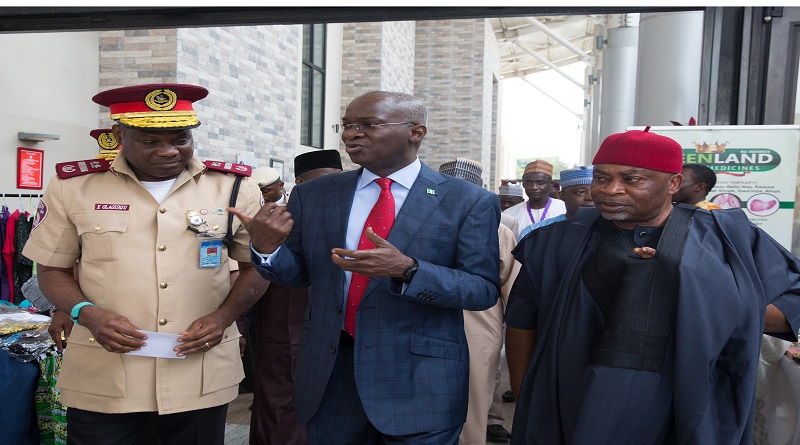Council on Works calls for provision, standardisation of road signage by government at all levels
The National Council on Works rose from its 23rd Meeting in Abuja on Thursday July 23, 2017 with a call on governments at all levels in the country to adhere strictly to the provision and standardization of road traffic signage in order to reduce the incidence of road accidents and ensure comfort and safety for travellers on the nation’s highways.
The Council Meeting, which was presided over by the Minister of Power Works and Housing, Mr. Babatunde Fashola SAN, was declared open by the Minister of the Federal Capital Territory, Mallam Muhammad Musa Bello, represented by the Executive Secretary, Federal Capital Development Authority, Engr. Umar Jibril. The meeting was also attended by the Hon. Minister of State, Hon. Mustapha Baba Shehuri, the Chairman, House of Representatives Committee on Works, Hon. Toby Okechukwu, Permanent Secretaries in the Ministry, the Chairman, Federal Character Commission, Commissioners responsible for Works matters in the States of the Federation as well as senior officials of relevant Federal and State Ministries, Departments and Agencies, regulatory bodies and other stakeholders.
In a Communiqué at the end of the Meeting hosted by the Ministry of Power, Works and Housing at the NAF Conference Centre in Kado District of the Federal Capital Territory (FCT), the Council noted that installation of modern signage on the country’s highways would reduce the high rate of road carnage being recorded on the highways yearly.
While also urging the Governments to assist research bodies in the country to conduct more research in the production of road signage, the Council called on stakeholders to increase funding for the provision of the signage as well as conduct sensitization programmes to enlighten the public on their use.
In order to ensure effective monitoring of traffic on the highways, it called on the Federal, States and Local Governments to approve the use of reflectometer as a quality monitoring device on the highways while urging Federal and State Governments to install ICT cameras and Traffic Aids Posts for recording traffic violations and to enforce compliance by road users.
Also to further improve monitoring on the highways, the Council recommended the use of survey techniques of RADAR (Radio Direction and Ranging) and LIDAR (Light Direction and Ranging) in monitoring traffic signage, checking vehicular movement and recording of traffic offences such as flouting the speed limits, beating of traffic lights and failures to respect traffic signage such as zebra crossing, among others.
Noting that indiscriminate use of billboards and other forms of adverts on road signage constitutes a menace on the highways, it urged all stakeholders to sensitize the public on the negative consequences of defacement, damage and removal of traffic signs on Nigerian roads while also calling for the establishment of Monitoring and Enforcement Units at Federal and State levels to ensure adherence to the use of road signs.
The Council, which noted that the use of unstandardized traffic calming techniques, such as bumps, logs of wood and tyres, defaced the roads and reduced their aesthetics conditions as well as that of the environment, urged government at all levels to adopt the use of modern and standard traffic calming techniques such as impediment/ traffic diversion and standard road bumps adding that states should liaise with the Federal Road Safety Corps (FRSC) and Federal Ministry of Power, Works and Housing (FMPWH) to agree on a standard, which, according to them, should be adopted during the design stage of road projects.
Other road furniture recommended by the Council to improve safety and comfort on the nation’s highways include Survey Techniques used to demarcate, survey and ensure compliance to the Right of Way (RoW) and Solar Road Studs, which, according to them, are visible up to 800 meters in the night while also emitting, rather than reflecting, light, thereby warning drivers at road sections.
It encouraged stakeholders to be proactive in adapting new technologies such as performance retro-reflective materials for all road markings in order to advance road safety while they accepted that in all new bridge projects, the crash barriers should be made up of dwarf concrete walls and metal barriers.
On the importance of seeking alternative funding means for sustainable maintenance of street lighting and other road infrastructure by Governments at all levels, the Council, which listed such alternative funding means to include Public Private Partnership (PPP), the Special Energy Efficiency Lighting Fund, the Carbon reduction fund, among others, approved that adequate budgetary provisions be made for the provision of signage infrastructure.
In line with its call on Federal and State Governments to direct their relevant Ministries, Departments and Agencies (MDAs) to provide geo-spatial data for positioning and location of road signage, the Council approved that such geo-spatial data be provided by the use of modern survey techniques by the Office of the Surveyor-General of the Federation (OSGoF) and the Offices of the Surveyors – General of the States (OSGoS).
It noted that such Geo-spatial information would create database for national signage for emplacement, monitoring and maintenance of highways furniture and infrastructure adding that all State Governments that were yet to establish Asset Management Units to focus on building database of road furniture and road signage should do so.
While encouraging stakeholders in the road sector to consider the use of the LED Solar Road Studs in road design, the Council also urged them to adopt the use of Radio Frequency Identification Technology and other modern technologies and devices in the maintenance and sustenance of street lights along Nigerian Roads, asking them also to assist NITT to design a national strategic ITS plan for effective highways infrastructure and Traffic Management so as to enhance safety and comfort on the roads.
Commending the effort of the Yobe State Government in the establishment of computerized Vehicle Inspection Centres and Model Driving Schools, the Council urged other state governments that are yet to establish such Centres and Driving Schools to do so to provide better education for road users.
It also urged relevant government agencies to ensure regular review of Road Signs System to conform with the 1968 United Nations Convention adding that stakeholders involved in the review should be expanded to include Federal Ministry of Power, Works and Housing (Works Sector), State Ministries of Works and Transport, Federal Ministry of Transportation, Federal Roads Safety Corps, Vehicle Inspection Office (VIO) and the Nigeria Society of Engineers.
The Council, which recalled that Nigeria was represented at a workshop in Geneva, Switzerland by a group of experts on Road Signs and Signals, pointed out that a document was presented by the United Nations Economic Commission for Europe (UNECE) on the challenges associated with the interpretation and implementation of 1968 Convention on Road Signs and Signals.
It noted that a National Road Safety Strategy (2016 – 2020) document has been approved by the Federal Executive Council (FEC) and the National Economic Council (NEC) and called for the implementation of the document which, it said, could be accessed on http://frsc.gov.ng/ publications.
Noting that the Federal Ministry of Power, Works and Housing Highway Manual Part I: Design Volume VI: Road Traffic Signs and Road Markings 2013 was meant to ensure appropriate signage on the nation’s highways, the Council expressed delight that several jobs would be created among skilled and semi-skilled artisans through the adoption of the new technologies in the production of modern signage.
And in order to make education of road users on the use of advance road signage more effective, the Council suggested that the enlightenment be done in local languages urging the Federal Road Safety Corps (FRSC) and Vehicle Inspection Officers (VIO) as well as other stakeholders to intensify efforts on sensitization in motor parks, all places of worship, palaces of traditional rulers and other relevant places.
The Council had earlier considered the issues raised in the Memoranda presented at the Meeting and noted with delight the Status of Implementation of its key decisions at the 22nd Meeting of the Council which showed that out of the 37 resolutions adopted at the Meeting, 25 tasks were completed with seven in progress while five were “facing challenges”.
A total of 26 Memoranda were received and considered under seven thematic groups including Adequate Traffic Signage – An Essential Key for Highways Infrastructure, Safety and Comfort; The Role of Survey and Mapping to Road Signage; Quality Assurance in the Production and Installation of Road Signage; Standardization of Road Signage; Adherence to the Provision of Road Signage on the Highways; Managing the Challenges of vandalization and Damages to Road Signage and; the Relevance of Intelligence to Signage.




